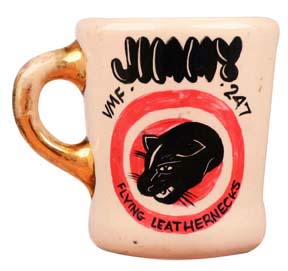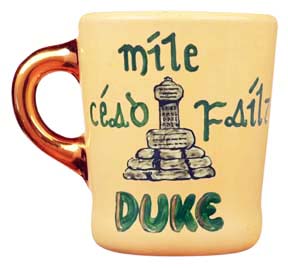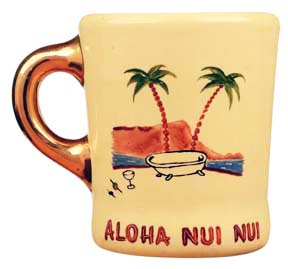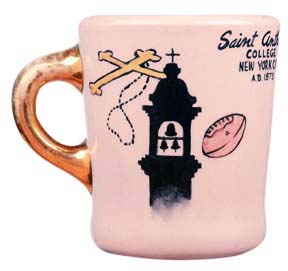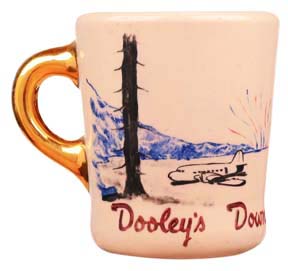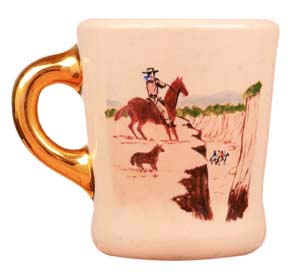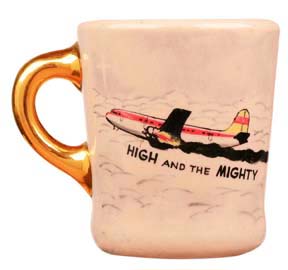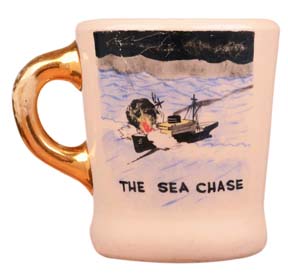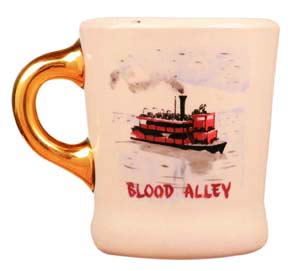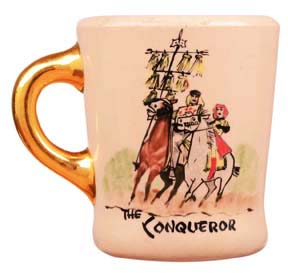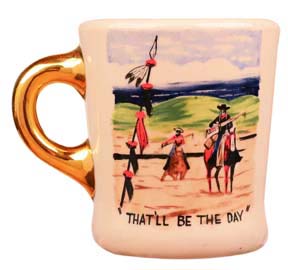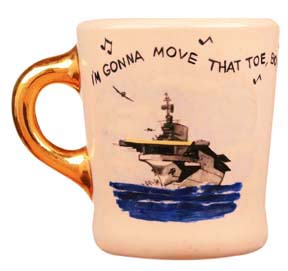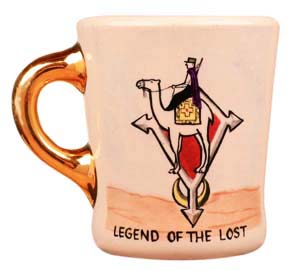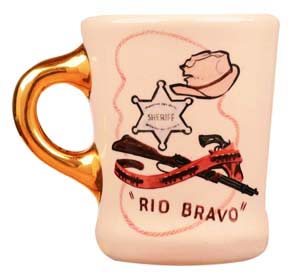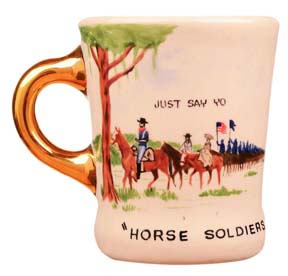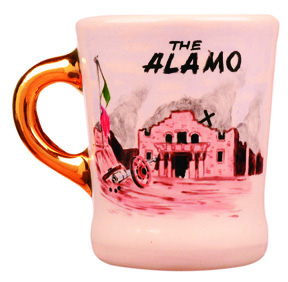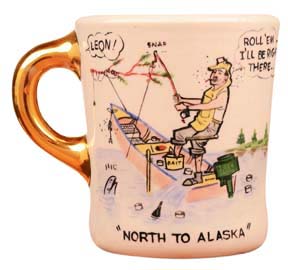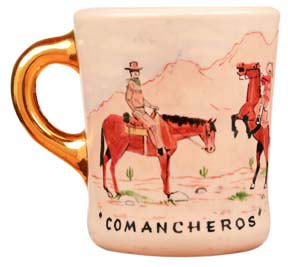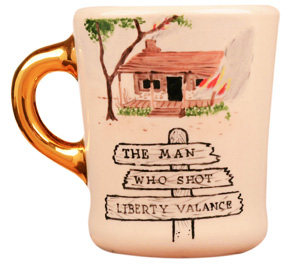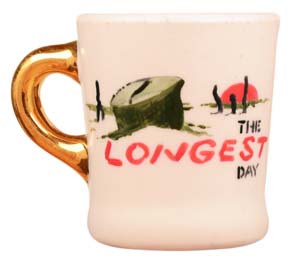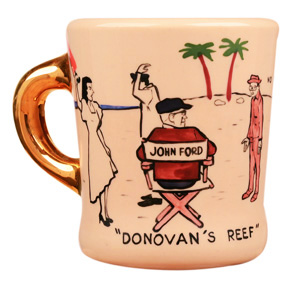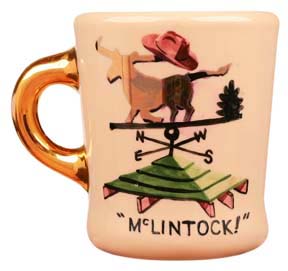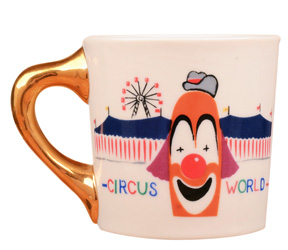
Bob McFarren
WHEN BOB McFARREN of Corona del Mar, California, took a course in ceramics in his pre-war high school days, he never thought that he and his wife, Jane, would be making their living with a portion of the knowledge gleaned from the course. It was this schooling, combined with the possibilities that sprang to mind when he saw an old-fashioned hand-painted shaving mug, that put him in business a few months ago. Following the war, McFarren returned to a job as a candy and tobacco salesman in which he regularly contacted all of the restaurants, cafes and coffee shops in his home territory of Orange County. It was after spotting one of the old shaving mugs in an antique shop with the original owner’s name painted across it, that he was struck with the possibility of making personalized coffee cups and using them as gifts. As a starter, in his back yard ceramics shop he turned out a few small-sized milk mugs and presented them to friends with children. On the pieces of pottery, he would first paint the child’s name and then bake it in a small electric kiln. Often he would draw a cartoon character taken from Mother Goose or one of the other nursery rhymes. NEXT McFARREN purchased a few china mugs from a Los Angeles concern, and painted on them the names of restaurant proprietors who were among his customers in the candy and tobacco business. Though the cups were ordinary restaurant-ware and had already been “burned” or baked once, McFarren simply painted them with commercial ceramic paints, put another coating of ceramic glaze on them, and rebaked the decorated mugs. The presentation of the completed cups was the start of what promises to be a profitable full time business. Though he made the first mugs which he decorated for his friends’ children, McFarren has found that for the hard use which many of the cups get, the heavy ready-made restaurant-ware, which is of a harder grade of china, is better suited. Therefore, he now purchases all of his cups ready-made from a Los Angeles wholesaling firm and decorates them before resale. The erstwhile salesman originally picked up a few commissions through his restaurant customers to do individual cups for their patrons. He soon found, however, that coffee clubs were being organized in the various towns where he called, and that the proprietors of the various coffee shops were encouraging such clubs. The mark of distinction was to have a McFarrenware cup hanging in the café. Using mixtures of his own concoction, Bob and his wife, Jane, paint the purchasers’ names on their respective cups, using commercially sold ceramic colors mixed with portions of either French fat oils or oil of clove.
“Anyone who tries this type of work is likely to prefer a different type of color mixture after a few experiments of his own,” McFarren asserts. The oils named are the best base that he has yet found in his own experience, however. ALTHOUGH HE has been decorating the mugs in his spare time for about two years, McFarren has only recently gone into it on a full time basis. Several months ago he suddenly realized that there was more actual profit in the hobby which he had developed than there was in the job which was keeping him busy five days per week. He reasoned that if he could devote all his time to “professional cup painting,” it might turn into something worthwhile. “Besides,” as he puts it, “I’m another of those people who has always wanted to be his own boss. This looked like the logical opportunity.” Thus far, McFarren’s entire business had stemmed from the restaurant and coffee shop owners that he presented with cups. Proud of the personal touch that the cups displayed, the proprietors had, in nearly every case, placed them in a prominent position in their places of business. Each time that the salesman would return, half a dozen or so of the firm’s customers would be clamoring for cups like the one he had given to the owner. The cafe owners soon became his agents and orders are placed through them. In every case they take orders for nothing, passing them on to McFarren. As one of them explains it, “Why should I ask for a cut out of the price of the cup, when each of them is actually improving my business? If a man has a cup with his name on it at my place, nine times out of ten, he’s going to come to my counter to drink his coffee. I want him to have the cup and leave it hanging in my place.” IN THE last few months, the McFarrens have turned out some 7,000 of the cups. Most of them have been distributed in the manner just described with the business on strictly a county level. Now, however, the business has started to expand and numerous persons who originally purchased cups for their personal use are calling upon the man-and-wife team to make complete sets as gifts for their friends and relatives in other sections of the country. In three different cases the McFarrens have been called upon to make cups bearing the names of persons who have died. In each case the circumstances were virtually identical. The cup’s owner had died and his relatives, for sentimental reasons, had picked it up from the restaurant or club where he had been in the habit of having his morning coffee. The dead man’s coffee-drinking friends, noting that the cup was missing, inquired into the matter and had then called upon Bob McFarren to make another cup identical with the one that had hung beside theirs during the man’s lifetime. In each case, the friends involved chipped in to pay for the cup that was again hung with theirs. WHEN HE first begin his cup-painting operations, Bob McFarren found that in order to make the colors stand out on the cups which had been previously baked by the original manufacturer, he needed higher temperatures than for those he had originally fashioned from clay, himself, and then painted. Whereas the average “green” piece of pottery or ceramic is fired at about 1,900 degrees Fahrenheit, he has found that the cups require about 2,400 degrees. Anything above that figure, however, is apt to result in a fading of the colors. Lately McFarren has been using gold colors on some of the cups as an added decoration. Through experimentation, he has found that the gold paint, which may be purchased at ceramic supply shops, fades to a dull brassy tint if it is baked at the same high temperature that is required to bring out the best in the other colors. Therefore, these pieces require two firings. The colors that require the high temperature are baked on the cups first, and later, the gold is added and the cup is again fired at a lower temperature. THE PRICE which the McFarrens charge for the cups is largely dependent upon the amount of work that goes into painting them.
Prices start at $1 per cup and go up to $1.50. In the bottom price level, McFarren uses mostly brown and green to paint with, as these fade the least should his baking temperatures vary a bit from the point which he has found best suited. If he or his wife is called upon to use additional colors such as red, yellow, blue or something else, the price rises. The price also advances with the amount of time that is consumed in the painting operations. A cup which a visitor to California ordered is one on which McFarren feels he may actually have lost money. The tourist ordered a cup bearing the likeness of the Oregon state capitol building, and even went so far as to furnish a picture of the structure for McFarren to copy. It took several hours to accomplish this chore, but McFarren still charged his top fee of only $1.50. The cup, incidentally, was slated as a gift to the governor of Oregon. McFARREN FEELS that one of the reasons why his mugs have proved successful is the fact that he has been able to pick out some particular characteristic of the person purchasing it, and, if the cup is to receive decorative work in addition to the name, include that mark of character in the art work. For instance, in a cup recently made for a Santa Ana attorney, he worked the lawyer’s name in brown letters and beneath painted a very thin and awkward-looking figure struggling with a heavy law book. The jury was represented in the small space allowed by showing the backs of a series of heads in the foreground. An order came in from a ski club which maintained a lodge in the nearby mountains. Each ski enthusiast who had ordered one of the mugs wanted his name on it, but also wanted a standard symbol to signify the fact that he was a club member. The result was a small picture of a pair of crossed broken skis with a bottle of iodine in the middle. The trademark resembled a skull and crossbones to a degree. Another club, composed of archery addicts, wanted a similar group of mugs made up for its membership. Besides the individuals’ names, McFarren fashioned a cartoon of an embarrassed archer face to face with a slightly perturbed moose that had an arrow protruding from one of its antlers. “In a few instances,” McFarren confesses, “I’ve been accused of having a sadistic streak of humor and picking on people’s weak points. I think, though, in most cases that they get a kick out of laughing at themselves.”
LAST YEAR, the McFarrens experienced a rush of business at Christmas time, with many an Orange county resident apparently deciding at the last minute that “Uncle Louis back in Sioux City would like nothing better than a coffee cup with his name on it.” For two months or so, the McFarrens had their own private Christmas rush, and both Bob and Jane were forced to work as much as eighteen and twenty hours per day, seven days a week, to fill the orders that came flooding in for the personalized mugs. They are already laying their plans for the coming yuletide season, too. The most famous of Pacific Coast art colonies, Laguna Beach, is down the coast only five miles, and the McFarrens have found that they can hire as many artists as they may find necessary, to help out if things should get too rushed. They hope, however, to do as much of the work as possible themselves. They are already urging the coffee-clubbers around the territory to get their orders in early if they expect to use sets of the mugs as Christmas gifts again this year. The holiday present orders are already coming in as a result. In what little spare time they have, the two still turn out a few ceramics, mostly, as Jane McFarren puts it, “just to keep in practice.” The hand-painted coffee cups are keeping them busy for as many hours each day as they care to work.
BEFORE TURNING to commercial cup-painting, the man-and-wife team started with a small electric kiln which would only bake two cups at a time. Recently, however, they have added to their capacity by purchasing two more electrically-heated kilns and another that is gas-heated. All together, they now have a capacity of about forty cups so far as firing them simultaneously is concerned. The electric-operated kilns cost about $50 each, while the gas-heated one, having a much greater capacity, ranged in the neighborhood of $400. According to McFarren, if the work concerned is not too minute and detailed, he and his wife can complete the painting and baking of about fifty cups per day. They feel that they clear somewhere in the neighborhood of $1 per cup, since most of the mugs ordered are in the maximum cost bracket. The mugs, when purchased at wholesale prices through the Los Angeles china concern, cost a little more than 30 cents each. To date, most of their business has been on a purely local plane with a few mail orders being filled as a result of word-of-mouth advertising. The McFarrens have decided, however, that should their business falloff to a point where they no longer have all they can handle, they will place advertisements in some of the better-known home service magazines. They hope eventually to expand to include the decoration of whole sets of dishes, purchasing the same heavy restaurant-ware plates, saucers and so on, and painting on them whatever designs the purchasers may desire. McFarren has already done some of this on a small scale, since a café operator in nearby Laguna Beach recently commissioned him to paint the establishment’s trademark on all of the chinaware and rebake it. The place, known as “Java Joe’s,” uses a picture of a small and rather sleepy-eyed Mexican as its own particular mark of distinction. The McFarrens painted this figure and the name of the business on all of the ware for a nominal price. AS THE number of coffee cups about the county increased and the individual memberships climbed, Bob McFarren realized that he should develop some system for simplifying the serving of coffee in the personalized cups. He had noticed that with help changing from time to time in the various establishments where his product had become a fixture, it was often hard for the new employees to identify each individual’s cup. Working it out with the dozen or so proprietors who had started the clubs, he decided to number the cups consecutively in each of the places. In this way, if a member comes in and a new employee is not acquainted with him or his coffee drinking habits, he has only to call for his cup by number and it is taken from its proper place on the rack. The number is painted somewhere on the cup so that it may easily be identified and placed in its correct position. Bob McFarren feels that there are several factors which are responsible for the success of the coffee mugs. First, a man likes to feel that he is an individualist and has a cup of his own. Secondly, the “keeping up with the Joneses” element may cause some to follow the example set by others. “I’ve noticed that when a restaurant operator gets a few of the cups in his place, everyone suddenly wants one,” McFarren says. “We have a big rush for a while and cannot keep up with the orders that are coming from the place. After a few weeks, though, the pace slows down and the club adds only a few new cup-owning members each week or so.” McFarren also feels that many of the cup purchasers may have done so for the free advertising involved. In fact, he has, veritable proof of this. “In more than one instance, I have sold cups to persons who seldom drink coffee,” he relates. “However, by putting their name and that of their firm on the cup, the free advertisement hangs in one of the more prominent spots in town where hundreds of people may see it each day. All that it costs the businessman is the price of the cup and a nickel or dime for the occasional mug of coffee that he may stop in to drink.”
As further proof of this, McFarren points out that most of his sales are to businessmen who pay his top price for the cups so that he will include not only their names, but their business trademarks as well.

